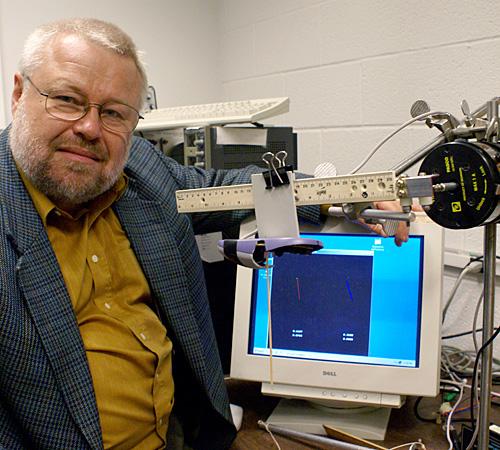Physics research blurs reality

After 10 years of research and experimentation, Alfred Hubler, associate professor of physics, has finally developed a way to synchronize reality with virtual reality, a state which he refers to as “mixed-reality.” Erica Magda
Apr 25, 2008
Last updated on May 13, 2016 at 10:23 a.m.
University physicists have blurred the lines of reality by creating the first mixed-reality state, which could give rise to a range of applications, including the control of cancer cells.
Alfred Hubler, associate professor of physics and head of the experiment , created the mixed-reality state through an experiment with two pendulums: one real and the other a virtual representation on a computer.
“Our experiment coupled a real system with a virtual-reality system,” Hubler said.
By making the two objects as similar to each other as possible, Hubler said he was able to get the two initially independent motions of the two pendulums to instantaneously move in tandem.
Get The Daily Illini in your inbox!
This created a mixed-reality state, a system in which two objects – one from the real world and one from the virtual world – mimic each other’s actions because of some kind of similarity, called “coupling.”
“(This experiment) is the first evidence of a mixed-reality state,” Hubler said.
While Hubler’s experiment is the first to couple objects in two different realities, it is a modern take on an age-old science curiosity: Huygens’ clock experiment.
“When you put two mechanical clocks on the wall, the clocks become coupled through faint vibrations through the wall,” Hubler said. “If the clocks are almost identical but slightly different, even though they initially show different times, they will at some point move together (and display the same time).”
The clocks would not synchronize gradually, however; they would instantaneously switch to display the same time. But when the clocks synchronize, they would continue moving together, and an observer would not be able to tell the slow clock from the fast clock.
Likewise, in Hubler’s pendulum experiment, it is not known which pendulum, virtual or real, has matched the other. Since there is no reference as to which pendulum has copied which, the boundary between the virtual world and the real world becomes unclear. The pendulums become essentially indistinguishable from each other.
While mixed reality may sound like the stuff of abstract theoretical science, humans experience mixed reality every day. Hubler describes it in terms of driving a car.
“Every human has a model of the world in their mind,” Hubler said. “When you are driving in your car, you have a virtual model in your mind of how the car should move. When the car moves (in the real world) like you expect (in the virtual model in your mind), you are experiencing mixed reality. The two realities are identical, coupled through your vision and feelings.”
Hubler said cancer cells could also be coupled using mixed reality. This would allow for selective elimination of cancer cells as well as much more effective treatments.
Recently, electric fields have been used to kill brain cancer cells. When cells divide, they weaken and can be killed by electric fields. Since healthy cells divide rarely in the brain, the brain can be safely zapped to kill the cancer cells but not the healthy ones.
“Regular brain cells divide extremely rarely. Therefore, electric fields can be used to treat brain cancer,” Hubler said.
However, in other areas of the body where healthy cells divide more often, the cancer cells cannot be so easily eliminated since any dividing healthy cells would also die.
Hubler’s research seeks to couple the real-world cancer cells to virtual-reality cancer cells so that scientists can coordinate the cancer cells to divide at the same time. That way, the cancer cells can be eliminated without harming the healthy cells which would all be at different dividing stages.
Very few healthy cells would be killed since they are not synchronized to divide with the cancer cells. Therefore, doctors can selectively and efficiently kill cancer cells, Hubler said.
However, the effects of mixed reality and coupling can be beneficial or detrimental depending on the situation.
Vadas Gintautas, graduate student and researcher of mixed reality, said one example is the possible use of video games for tactical training in the military. Video games create a mixed-reality state by coupling the virtual reality of the game to the virtual reality of the mind, he said.
“Soldiers could use modified versions of computer games, such as ‘Doom,’ to learn the geography of a city they are going to invade,” Gintautas said. “However, if the game is not randomized enough, they may face problems when they go into the actual city.”
Hubler said he admits that mixed reality can have negative effects, but these are balanced by the positive.
“There are dangers, but there are also many benefits,” Hubler said.





